Social
Contattaci
Indirizzo
Fondamenta Cristoforo Parmense 10 Murano VE
30141
Bellezza e serenità

Inferno, Canto VIII



Confronto
Invidiaolio su tela cm. 60x80
In posaolio su tela cm. 60x80
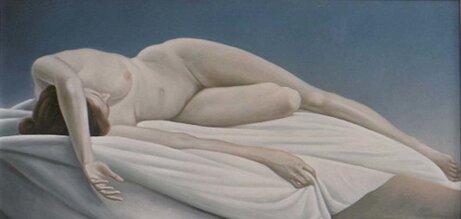
Nudo dormiente
I dipinti di Giampaolo Ghisetti rappresentano il succo trasfigurato dei suoi paesaggi, tra suggestivi scorci di Venezia, fitti boschi e antichi borghi animati dalla sola memoria, mentre si aprono alla luce ed all’aria.
Diceva Matisse : “ La pittura è rapporto” . E spiegava: “ Il rapporto è amore”. C’è in questa pittura la capacità di instaurare un rapporto amoroso con le cose, la delicatezza, come se i quadri fossero liriche lontananze.
La stessa natura appare nel dipinto filtrata, quindi, riassapora tra i preziosi valori dei verdi che si integrano con la leggerezza dell’aria di un azzurro terso, che rende limpide e chiare le vedute, libere, senza costrizioni.
Vi sento il respiro di un’illustre civiltà che nasce dall’impressionismo francese e che evolve verso un’ambientazione sognante, mentre nelle prospettive dilatate dalle emozioni interiori, essa diviene quasi metafisica nei silenzi d’animo. Nessuna forzatura, bensì l’attenzione estrema nel cogliere col massimo di sensibilità quel certo punto luce, quella gradazione esatta di tono, quella tal vibrazione dell’aria.
Questo è dunque impressionismo? Non propriamente. La fenomenicità della visione, tipica di Monet, subisce una sorta di passaggio, attraverso il ricordo che avanza. La differenza non è evidente, ma la fragranza dell’emozione cede il passo alla nostalgia dell’attimo perso.
Ecco quindi, i suoi paesaggi si aprono a vedute metafisiche, così limpide, in cui i toni cantano armoniosamente le ocra dorate, gli azzurri celestini, i verdi variegati della vegetazione, dove la natura diviene una musica vivaldiana: una melodia tranquilla, in cui le immagini si illuminano di bianca luce nella conciliazione tra senso ed intelletto, natura ed onirica geometria.
Ghisetti ha il coraggio di misurarsi con i grandi artisti del passato storico della pittura non solo italiana, da Cezanne al Carrà nella poesia del quotidiano, cogliendo nell’armonia la lezione della pittura come trasfigurazione della luce, come magia dei sensi ed incantamento dell’anima. Ma nel contempo guarda alla natura, cercando da essa gli stimoli visivi come sentimentali, per quel rapporto di cui parlava Matisse.
Nella sua splendida pittura si percepisce questa sua esigenza primaria di dialogo con il dato naturale nella sospensione di preziosi attimi. Alla fine, l’illusione e lo straniamento delle realtà ci trasportano verso una dimensione esistenziale dell’autore, una dimensione quasi dorata, in cui è bello vivere nei sentimenti che solo il linguaggio universale dell’arte può trasmettere ad ognuno di noi in un nuovo sogno.
Carla d’Aquino
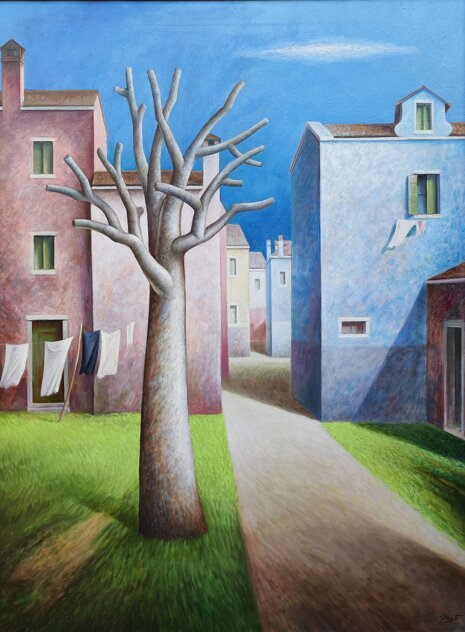
Pensando Burano



Natura morta con orate
Lagunare
Il Da Mula

Regata in Laguna

Murano

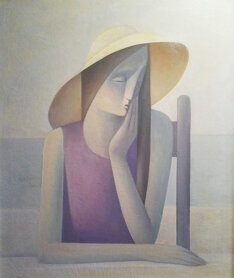

Alla finestra
Ragazza con cappello
Boccolo


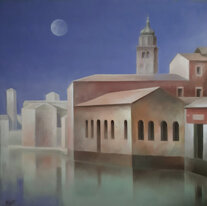
Campo del Cimitero, Murano
Canale a Murano
Fabbriche a Murano

Sacra famiglia 2000
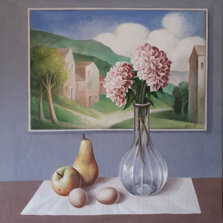
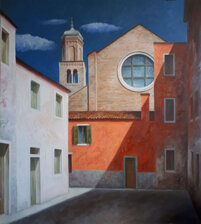
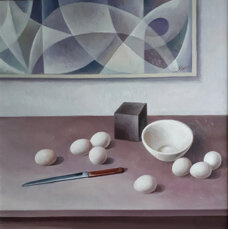
Natura morta
Natura morta con uova
Campiello a Murano

Alla finestra
The paintings by Giampaolo Ghisetti represent the memory of landscapes, suggestive views of Venice, dense forests and ancient villages brought to life by the memory alone and opened to light and air.
Matisse said: "Painting is a relationship." And he explained, "The relationship is love." There is in this painting the ability to establish a loving relationship with things and delicacy, as if the paintings were lyrical distances.
This same nature appears in the painting completely filtered, therefore, reassembles among the precious values of the green integrate with the lightness of a clear blue air, which makes clear and pale the views, free, without constraints.
I feel the breath of an illustrious civilization that is born of French impressionism and evolves into a dreamlike setting.
Dilated by inner emotions, it becomes almost metaphysical in silence of mind. No forcing, but extreme attention in capturing with the utmost sensitivity that particular light point, that exact gradation of tone, and vibration of the air.
Is this therefore impressionism? Not really.
The phenomenon of vision, typical of Monet, undergoes a sort of passage through the memory that advances. The difference is not obvious, but the fragrance of emotion gives way to the nostalgia of the lost moment.
So its landscapes are open to metaphysical views, so clear that the tones harmoniously sing golden gilt, blue celestial, green variegated vegetation, where nature becomes a Vivaldi music: a quiet melody, in which the images illuminate white light in the conciliation between sense and intellect, nature, and dreamlike geometry.
Ghisetti has the courage to measure with the great artists of the historical past oand not only of Italian painting.
From Cezanne to Carrà in the poetry of everyday life, drawing in harmony the lesson of painting as the transfiguration of light, as the magic of the senses and the enchantment of the soul .
But at the same time he looks at nature, looking for visual stimuli as sentimental, for that relationship Matisse talked about.
In his beautiful painting, he perceives his primary need for dialogue with the natural figure in the suspension of precious moments.
In the end, the illusion and the strangeness of reality transport us to an existential dimension of the author, an almost golden dimension, in which it is nice to live in the feelings that only the universal language of art can transmit to each of us in a new dream.
Carla d'Aquino Mineo



Caigo
Fondamenta Serenella
Verso mattima
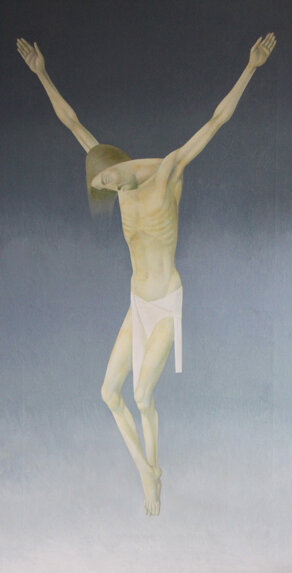
Jesus